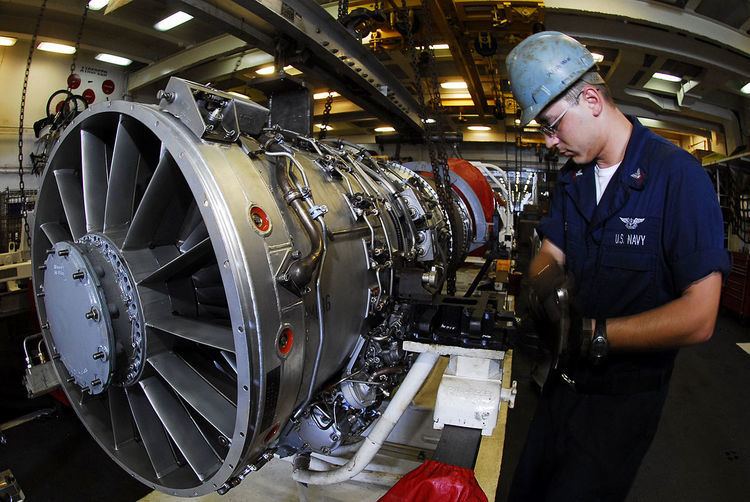The Pratt & Whitney J52 (company designation JT8A) is an axial-flow dual-spool turbojet engine originally designed for the United States Navy, in the 9,000 lbf-class. It powered the A-6 Intruder and the AGM-28 Hound Dog cruise missile. The engine is still in use in 2011 in models of the A-4 Skyhawk and the EA-6B Prowler.
The engine provided the basis for the Pratt & Whitney JT8D, a popular civilian low-bypass turbofan engine.
Design and development
The J52 was developed in the mid-1950s for the US Navy as a scaled-down derivative of the J57/JT3A. It was initially intended to power the A4D-3 Skyhawk, an advanced avionics model that was canceled in 1957. After being canceled, the U.S. Air Force selected the J52 to power the AGM-28 Hound Dog cruise missile. The engine was designed with several unique features for this application, including a "conical centerbody mounted in the intake" and a "variable central plug ... in the nozzle". Then, in 1958, the US Navy selected the engine to power what became the A-6 Intruder.
The J52-P-6 model, designed for the YA2F-1 (YA-6A) Intruder, had a unique nozzle that could be angled downward at 23 degrees for STOL takeoffs; this was not used on production A-6s. Returning full circle, the J52 was selected to power the A4D-5, another model of the A-4 Skyhawk, remaining in all subsequent new-built models.
The twin-spool J52 employs a split 12-stage axial compressor consisting of a five-stage low pressure unit and a seven-stage high pressure unit. Behind the compressor is a nine-unit can-annular combustion chamber and a two-stage split turbine.
J52-P-3Flown in: AGM-28 Hound Dog. This variant produced 7,500 lbf (33,000 N) of
thrust. The design of the P-3 model included a variable inlet duct to improve engine efficiency at the various altitudes the cruise missile was designed to fly at.
J52-P-6Flown in: A-6A. This variant produced 8,500 lbf (38,000 N) of thrust and included the 23-degree downward swiveling nozzle.
J52-P6AFlown in: A-4E, TA-4J, EA-6B (the first few). This variant produced 8,500 lbf (38,000 N) of thrust.
J52-P-8A/BFlown in: A-4F/G/H/K, TA-4E/F/G/H, A-6E, EA-6B. This variant produced 9,300 lbf (41,000 N) of thrust.
J52-P-408Flown in: A-4M/N, TA-4KU, EA-6B. This variant included variable inlet guide vanes (
VIGV) in the LPC, air-cooled turbine blades, and produced 11,200 lbf (50,000 N) of thrust. Still in operation with
Argentina,
Brazil, and
IndonesiaJ52-P-409Also known as
PW1212. 12,000 lbf (53 kN) thrust version of the J52-P-408 with an improved low pressure turbine (LPT) and faster acceleration. Designed for the EA-6B and was additionally marketed as an upgrade for the A-4. The J52-P-409 was also proposed as a cost-effective upgrade to the A-6E as an alternative to the A-6F Intruder II, but was not purchased. The P-409 engine was also proposed for use in the EA-6B ADVCAP, but that program was canceled after three prototypes were built and flown. The P-409 would have been available as a new engine or as an upgrade kit for P-408 engines, but was never ordered in significant quantities.
PW1216An afterburning derivative of the J52-P409 engine proposed for the Grumman Sabre II concept (the project later evolved into the JF-17 Thunder). The afterburner, designed in
China, would have increased thrust to 16,000 lbf (71 kN).
JT8ACompany designation for initial versions of the J52
JT8B-1(J52-P-6)
AGM-28 Hound DogDassault Super MystereDouglas A-4 SkyhawkGrumman A-6 IntruderLockheed Martin A-4AR FightinghawkNorthrop Grumman EA-6B ProwlerLIMRV - On 14 August 1974, the LIMRV achieved a world record speed of 255.7 mph (411.5 km/h)Data from Flight
Type: TurbojetLength: 118 in (300 cm)Diameter: 38 in (96.5 cm)Dry weight: 2,318 lb (1,052 kg)Compressor: Axial flow, 5-stage LP, 7-stage HPTurbine: Single stage HP, single stage LPFuel type: JP-4Maximum thrust: 11,200 lbf (50.0kN)Overall pressure ratio: 14.6 : 1Air mass flow: 143 lb/secSpecific fuel consumption: 0.89 lb/lbf*hrThrust-to-weight ratio: 4.83:1
